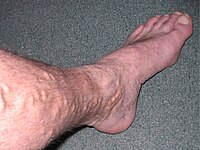
Photo from wikipedia
Objectives The aim of this study was to systemically review and analyze the efficacy of cyanoacrylate ablation (CA) in comparison with endovenous thermal ablation (ETA) for the treatment of incompetent… Click to show full abstract
Objectives The aim of this study was to systemically review and analyze the efficacy of cyanoacrylate ablation (CA) in comparison with endovenous thermal ablation (ETA) for the treatment of incompetent saphenous veins. Methods A systematic literature search was conducted using databases of Pubmed, Embase, and Cochrane Library from the times of their inception to April 2020. Studies were selected based on inclusion and exclusion criteria after assessing the risk of bias in comparative studies with Cochrane and rating quality of evidence with the GRADE methodology. The meta-analysis was carried out using the Review Manager 5.4 program to conduct homogeneity tests. Results One cohort study and three randomized controlled trials (RCT), including a total of 1457 participants were included in the meta-analysis. ETA included endovenous laser ablation (ELVA) and radiofrequency ablation (RFA) in the selected studies. Comparison between CA and a combination of EVLA and RFA or RFA alone were carried out in two of RCTs, while comparison between CA with EVLA was conducted in one RCT and the cohort study. There was no statistical difference in closure rates between CA and ETA after pooled analysis. Similar symptom alleviation observed between different groups. However, the CA group showed a lower ecchymosis rate than RFA and a significantly lower incidence of adverse events, such as ecchymosis, phlebitis and paresthesia, than EVLA. Compared with ETA, the patients received CA treatment exhibited lower pain scores in a shorter procedure duration without needing compression stocking, returned to normal life sooner, and had significantly better quality of care. There was no significant difference in the number needed to treat for additional therapy after three months of follow-up between groups. Conclusions This meta-analysis indicates that CA has better overall outcomes than ETA and offers superior clinical benefits in the treatment of incompetent saphenous veins.
Journal Title: Phlebology
Year Published: 2021
Link to full text (if available)
Share on Social Media: Sign Up to like & get
recommendations!